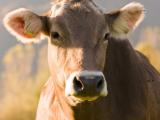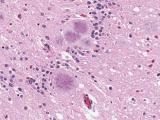May 8, 2006 (CIDRAP News) – US officials have closed the investigation into the nation's latest case of bovine spongiform encephalopathy (BSE), or mad cow disease, without finding the infected cow's origins.
John Clifford, the US Department of Agriculture's chief veterinary officer, announced the end of the investigation into the Alabama case on May 2.
The USDA Animal and Plant Health Inspection Service (APHIS) had been trying to learn since mid-March where the Alabama cow came from so it could trace other cattle that might have been exposed to the same feed the cow ate in early years. Cattle are believed to contract the disease by eating contaminated feed.
"APHIS's investigation did not reveal the BSE-positive animal's herd of origin," Clifford said in a written statement. "However, this was not entirely unexpected due to the age of the animal, along with its lack of identifying brands, tattoos and tags. Experience worldwide has shown that it is highly unusual to find BSE in more than one animal in a herd or an infected animal's offspring."
The cow, described as a red crossbreed, was euthanized and tested in March after it was found unable to walk. After a veterinarian took a sample for testing, the cow was buried on the farm, but officials later dug up the carcass to determine its age. They concluded that it was more than 10 years old and therefore was born before the government's 1997 ban on use of cattle protein in feed for cattle and other ruminant animals.
Clifford said APHIS and Alabama officials investigated 36 farms and five auction houses and conducted DNA tests in a hunt for relatives of the infected cow. They found none besides than the cow's two latest calves. The most recent calf was found on the same farm as its mother and is now being held for observation at APHIS's national laboratory in Ames, Iowa. The other calf died last year, he said. An Associated Press report said that calf was buried in a landfill.
The Food and Drug Administration (FDA) investigated feed mills that might have supplied feed to the cow after the 1997 feed ban, Clifford reported. "This investigation found that all local feed mills that handle prohibited material have been and continue to be in compliance with the FDA's feed ban," he said.
The Alabama cow was the nation's third BSE case. On the basis of tests of more than 700,000 cattle over the past 2 years, the USDA recently estimated that another four to seven cases could exist in the United States.
See also:
May 2 statement by John Clifford of USDA
Mar 13 CIDRAP News story "Alabama cow positive for BSE"


















